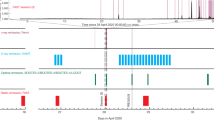Abstract
The origin of γ-ray bursts—which are among the most energetic events in the Universe—has puzzled astronomers for 25 years. Since 1991, new events have been discovered at a rate of about one per day, but because their positions were poorly determined, the objects responsible for these outbursts could not be identified. Now, following the launch of the BeppoSAX satellite in 1996, γ-ray bursts have been rapidly and accurately located, which has led to the breakthrough discoveries of X-ray and optical counterparts in 1997, and the demonstration that these objects are in general very distant.
This is a preview of subscription content, access via your institution
Access options
Subscribe to this journal
Receive 51 print issues and online access
$199.00 per year
only $3.90 per issue
Buy this article
- Purchase on Springer Link
- Instant access to full article PDF
Prices may be subject to local taxes which are calculated during checkout


Similar content being viewed by others
References
Klebesadel, R. W. et al. Astrophys. J. 182, L85–L88 (1973).
Atteia, J. L. et al. Asecond catalog of gamma-ray bursts—1978–1980 localizations from the interplanetary network. Astrophys. J. Suppl. 64, 305–382 (1987).
Barthelmy, S. D. et al. in Gamma-Ray Bursts (eds Fishman, G. J., Brainerd, J. J. & Hurley, K.) 643–647 (AIP Conf. Proc. 307, Am. Inst. Phys., New York, 1994).
Sokolov, V. V., Kopylov, A. I., Zharykov, S. V., Kurt, V. G. & Berezin, A. V. The search and investigation of faint blue star-like objects in the GRB error boxes. Astrophys. Space Sci. 231, 343–346 (1995).
Harrison, T. E., McNamara, B. J. & Klemola, A. R. Optical studies of gamma-ray burst fields, 1: GRB 790329. Astron. J. 107, 254–260 (1994).
Vrba, F. J., Hartmann, D. H. & Jennings, M. C. Deep optical counterpart searches of gamma-ray burst localizations. Astrophys. J. 446, 115–149 (1995).
Larson, S. B., McLean, I. S. & Becklin, E. E. Luminous galaxies near gamma-ray burst positions. Astrophys. J. 460, L95–L97 (1996).
Boer, M. et al. ROSAT-pointed observations of two gamma-ray burst error boxes. Astron. Astrophys. 277, 503–509 (1993).
McNamara, B. J. et al. Ground-based gamma-ray burst follow-up efforts: results of the first two years of the BATSE/COMPTEL/NMSU rapid response network. Astrophys. J. Suppl. 103, 173–181 (1996).
Hudec, R. et al. European observation network: first experience with BACODINE triggers. Astrophys. Space Sci. 231, 335–338 (1995).
Feroci, M. et al. BeppoSAX follow-up search for the X-ray afterglow of GRB970111. Astron. Astrophys. 332, L29–L33 (1998).
Galama, T. et al. The decay of the optical emission from the γ-ray burst GRB970228. Nature 387, 479–482 (1997).
Sahu, K. C. et al. The optical counterpart to γ-ray burst GRB 970228 observed using the Hubble Space Telescope. Nature 387, 476–0-478 (1997).
Harrison, T. E., McNamara, B. J. & Mason, P. A. IAU Circ.No. 6632 (1997).
Sahu, K. C. et al. Observations of GRB 970228 and GRB 970508 and the neutron star merger model. Astrophys. J. 489, L127–L131 (1997).
Metzger, M. R. et al. Spectral constraints on the redshift of the optical counterpart to the γ-ray burst of 8 May 1997. Nature 387, 878–880 (1997).
Frail, D., Kulkarni, S. R., Nicastro, S. R., Feroci, M. & Taylor, G. B. The radio afterglow from the γ-ray burst of 8 May 1997. Nature 389, 261–263 (1997).
Connaughton, V., Kippen, R. M., Preece, R., Pendleton, G. N. & Barthelmy, S. D. IAU Circ.No. 6683 (1997).
Marshall, F. E., Takeshima, T., Barthelmy, S. D., Robinson, C. R. & Hurley, K. IAU Circ.6683 (1997).
Murakami, T., Fujimoto, R., Ueda, Y. & Shibata, R. IAU Circ. No. 6687 (1997).
Griener, J. et al. IAU Circ. No. 6722 (1997).
Harrison, T. E. et al. IAU Circ. No. 6721 (1997).
Stanek, K. Z., Sasselov, D. D., Garcia, M. R. & Robinson, C. R. IAU Circ. No. 6723 (1997).
Kulkarni, S. R. et al. IAU Circ. No. 6723 (1997).
Remillard, R., Wood, A., Smith, D. & Levine, A. IAU Circ. No. 6726 (1997).
Castro-Tirado, A. J. et al. IAU Circ. No. 6730 (1997).
Frail, D. A. & Kulkarni, S. R. IAU Circ. No. 6730 (1997).
Heise, J. et al. IAU Circ. No. 6787 (1997).
Halpern, J., Thorstensen, J., Helfand, D. & Costa, E. IAU Circ. No. 6788 (1997).
Rhoads, J. IAU Circ. No. 6793 (1997).
Diercks, A. et al. IAU Circ. No. 6791 (1997).
Kulkarni, S. R. et al. Identification of a host galaxy at redshift z = 3.42 for the γ-ray burst of 14 December 1997. Nature 393, 35–39 (1998).
Coletta, A. et al. IAU Circ. No. 6796 (1997).
Piro, L. et al. IAU Circ. No. 6797 (1997).
Paczynski, B. & Rhoades, J. E. Radio transients from gamma-ray bursters. Astrophys. J. 418, L5–L8 (1993).
Katz, J. I. Low frequency spectra of gamma-ray bursts. Astrophys. J. 432, L107–L109 (1994).
Meszaros, P. & Rees, M. Optical and long-wavelength afterglow from gamma-ray bursts. Astrophys. J. 476, 232–237 (1997).
Liang, E., Kusunose, M., Smith, I. A. & Crider, A. Physical model of gamma-ray burst spectral evolution. Astrophys. J. 479, L35–L38 (1997).
Katz, J. I., Piran, T. & Sari, R. Implications of the visible and X-ray counterparts to GRB970228. Phys. Rev. Lett. 80, 1580–1581 (1998).
Tinney, C., Stathakis, R., Cannon, R. & Galama, T. IAU Circ. No. 6896 (1998).
Djorgovski, S. G. et al. The optical counterpart of the γ-ray burst GRB970508. Nature 387, 876–878 (1997).
Acknowledgements
We thank J. Ryan, G. Fishman and W. Webber for their long-term support of GRB counterpart search work. We also acknowledge the support of NASA.
Author information
Authors and Affiliations
Rights and permissions
About this article
Cite this article
McNamara, B., Harrison, T. The optical counterparts of γ-ray bursts. Nature 396, 233–236 (1998). https://doi.org/10.1038/24317
Issue Date:
DOI: https://doi.org/10.1038/24317
This article is cited by
-
Supernova explosions in the Universe
Nature (2000)
Comments
By submitting a comment you agree to abide by our Terms and Community Guidelines. If you find something abusive or that does not comply with our terms or guidelines please flag it as inappropriate.



